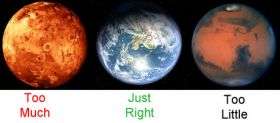NASA images of Jupiter's moon, Io, (left) Earth (center) and Mars (right), respectively, illustrate worlds with too much, just enough and too little tidal heating to favor life. Internal heating can dramatically affect the suitability of a planet for life. Internal heating produced by tides in Io is so strong the moon undergoes powerful global-scale volcanism. Earth's moderate internal heating drives plate tectonics that create a surface suitable for life. The negligible tidal heating of Mars may be why the planet is so geophysically dormant at present, possibly making it too cold for life.
(PhysOrg.com) -- Astronomers searching for rocky planets that could support life in other solar systems should look outside, as well as within, the so-called "habitable zone," University of Arizona planetary scientists say.
Planets too close to their stars are roasted. Planets too far from their stars are frozen. In between, research models show, there's a habitable zone where planet temperatures approximate Earth's. Any rocky planets in this just-right Goldilocks zone could be awash in liquid water, a requisite for life as we know it, theorists say.
New research by Brian Jackson, Rory Barnes and Richard Greenberg of UA's Lunar and Planetary Laboratory shows that tides can play a major role in heating terrestrial planets, creating hellish conditions on rocky alien worlds that otherwise might be livable. And just the other way, tidal heat can also create conditions favorable to life on planets that would otherwise be unlivable.
Jackson presented the research Saturday at the 40th annual meeting of the Division of Planetary Sciences in Ithaca, N.Y. His talk is titled "Tidal Heating of Extrasolar Terrestrial-scale Planets and Constraints on Habitability." The research will be published soon in the Monthly Notices of the Royal Astronomical Society.
Our own solar system is something of an anomaly, in that its planets move in relatively quiescent, circular orbits around the sun. Most extrasolar planets found to date have highly elongated orbits. During each orbit, the planet is stretched most by tides when it is near the star, and less when the planet is farther from its star. The resulting friction generates internal heat, which drives the planet's geophysical processes.
If the recently discovered "super-Earths" – extrasolar planets only 2-to-10 times as massive as Earth – are indeed terrestrial, tidal heating may be great enough to melt them, or at least produce volcanism on par with Jupiter's moon, Io, "dimming their prospects for habitability," Jackson said. So some of the recently discovered super-Earths may be more like "super-Ios," he said. The lo moon is the most volcanically active body in our solar system.
"Tidal heating scales with planet mass, so we expect that most easily detectable super-Earths will be dominated by volcanic activity," Jackson said. "That's one of our first conclusions from this work, that the first Earth-like planets found are probably going to be strongly heated and have big volcanoes. Even if Earth-like planets are found within the habitable zone, they may not be habitable because they will be overwhelmed by this tidal heating."
Tidal heating may also create habitable conditions on planets that otherwise are too small or too cold to support life, Jackson said. Tidal heating can enhance outgassing of volatiles that contribute or replenish a planet's atmosphere through volcanism. Tidal heating also can generate sub-surface liquid oceans on water-rich rocky planets that would otherwise be frozen, just as tidal heating is believed to warm a sub-surface liquid water ocean on Jupiter's moon Europa.
Also, tidal heating can drive plate tectonics, a mechanism that checks excessive carbon dioxide from accumulating in a planetary atmosphere, producing the kind of deadly greenhouse atmosphere found on Venus.
"Our study shows that tidal heating could produce enough heat to drive plate tectonics for billions of years, long enough for life to appear and flourish," Jackson said.
Provided by University of Arizona
























